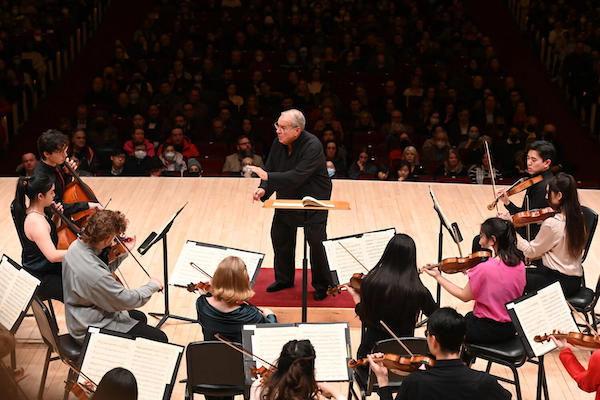Young players of NY String Orchestra offer heartening classical future

The New York String Orchestra, an ensemble of exceptionally gifted players in their teens and early twenties, offered a program of two symphonies and a concerto Wednesday night in Carnegie Hall—and the best symphony was the concerto.
Two favorite symphonies—Prokofiev’s No. 1, “Classical,” and Mendelssohn’s No. 3, ”Scottish”—had some difficulty getting airborne under the direction of conductor Jaime Laredo, despite able and energetic playing from his troops.
On the other hand, Beethoven’s Piano Concerto No. 5, “Emperor”—thanks in part to the addition of a noted Beethovenian, Jonathan Biss, as soloist—got up a splendid head of symphonic steam in the orchestral passages.
The concert was a product of the New York String Seminar, an annual ten-day program for young musicians from the New School’s Mannes College of Music, whose alumni list ranges from star soloists to principal players in top orchestras.
The venerable annual event, founded in 1969 by arts manager Frank Salomon with violinist and conductor Alexander Schneider, brings together 60 or so of the nation’s (and the world’s) most accomplished young players of stringed and other instruments for ten days of coaching and rehearsals around the December holidays, culminating in two orchestral concerts on Carnegie’s fabled stage.
The first of this year’s set, on Christmas Eve, was a modest offering of strings-only favorites by Elgar, Mozart, Bach, and Tchaikovsky. Wednesday’s program tackled more robust symphonic fare—hopefully still with the chamber-music ethos that has imbued the program under its two conductors: Schneider formerly of the Budapest Quartet, followed by Laredo of the long-running Kalichstein Laredo Robinson Trio.
Perhaps ten days of preparation wasn’t enough to consistently produce that wind-beneath-your-wings feeling that seamless chamber-music playing—and the best orchestral performances—can deliver. But at their best, the young musicians clearly projected the music’s character and dazzled with their virtuosity.
Certainly they attacked Prokofiev’s effervescent score with admirable accuracy and gusto, even if the result was a few bubbles short. The middle movements, a dainty Larghetto and a droll Gavotte, while well characterized, would also have benefited from more bounce and lift.
But one could hardly have asked for a more “Molto vivace” finale than the young players delivered, exultantly displaying their chops as they took the corners fast and tight.
Playing the Beethoven, Biss, the thinking man’s pianist, managed some fine flourishes in the attention-grabbing opening, but tended to prefer an expressive range from dreamy to very dreamy. This time it was the orchestra that stepped up, pushing the soloist to be more assertive. When he weakened the theme a bit by rushing it, Laredo and his players snapped it right back in time.
On the other hand, Biss’s imaginative playing seemed to inspire his collaborators, who engaged him with some fine wind solos and spun out an exciting first-movement coda.
It was the same only more so in the Adagio un poco mosso, as soloist, muted strings, and a soulful bassoon vied to see who could stretch out the cantabile theme more gorgeously. Biss somewhat rushed the finale’s theme, spoiling the joke of the orchestra’s syncopated version, but once things were righted rhythmically the brilliant scales flowed, the themes slid smoothly into place, and Beethoven’s quirky humor paid off with interest.
One would like to report that the rhythmic élan of the concerto performance carried over into Mendelssohn’s symphony, but the opposite was the case. After a sonorous slow introduction, the Allegro un poco agitato couldn’t quite get the lead out, which led to some raggedness of ensemble. The scherzo-like second movement sounded perky and plenty Scottish, if not as lucid as one wants for Mendelssohn, but energy and enthusiasm carried the day.
A pretty pairing of flute and violins soared in the Adagio, and the inexorable dotted rhythm of the funeral-march episode was precisely executed, although Laredo and his players did little to highlight the march’s contrasts between mysterious minor and glaring major.
Though marked “Allegro vivacissimo,” the fast finale had more stomp than fly, and accents became anchors. As a result, it was hard to generate excitement, at least until the splendid maestoso closing pages, which are almost guaranteed to send listeners away happy.
Wednesday’s listeners lustily applauded the young players not only for a fine, sometimes brilliant concert, but for the years of dedication that have brought them this far. It’s good to know that superb young musicians, and veteran concertgoers to listen to them, are both renewable resources.